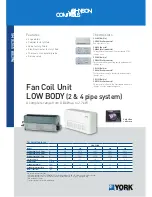
CLB/EN (1901) 6.6
Problem solving
31
CombiLineBloc
6 Problem solving
Faults in a pump installation can have various causes. The fault may not be in the pump, it
may also be caused by the pipe system or the operating conditions. Firstly, always check
that installation has been executed in accordance with the instructions in this manual and
that the operating conditions still correspond with the specifications for which the pump
was purchased.
In general, breakdowns in a pump installation are attributable to the following causes:
• Faults with the pump.
• Breakdowns or faults in the pipe system.
• Faults due to incorrect installation or commissioning.
• Faults due to incorrect choice of pump.
A number of the most frequently occurring failures as well as their possible causes are
shown in the table below.
Table 7: Most frequently occurring failures.
Most common faults
Possible causes, see Table 8.
Pump delivers no liquid
1 2 3 4 8 9 10 11 13 14 17 19 20 21 29
Pump has insufficient volume flow
1 2 3 4 8 9 10 11 13 14 15 17 19 20 21
28 29
Pump has insufficient head
2 4 13 14 17
Pump stops after start up
1 2 3 4 8 9 10 11
Pump has higher power consumption than
normal
12 15 16 17 18 22 23 24 25 26 27 32
38 39
Pump has lower power consumption than
normal
13 14 15 16 17 18 20 21 28 29
Mechanical seal has to be replaced to
often
23 25 26 30 32 33 36
Pump vibrates or is noisy
1 9 10 11 15 18 19 20 22 23 24 25 26
27 29 37 38 39 40
Bearings wear too much or become hot
23 24 25 26 27 37 38 39 40 42
Pump running rough, hot or seizes
23 24 25 26 27 37 38 39 40 42
Summary of Contents for SPX Flow CombiLineBloc
Page 2: ......
Page 6: ...4 INT EN 1512 1 2 ...
Page 10: ...8 CLB EN 1901 6 6 ...
Page 14: ...12 Introduction CLB EN 1901 6 6 ...
Page 26: ...24 General CLB EN 1901 6 6 ...
Page 44: ...42 Disassembly and assembly CLB EN 1901 6 6 ...
Page 50: ...48 Dimensions CLB EN 1901 6 6 ...
Page 56: ...54 Parts CLB EN 1901 6 6 ...
Page 66: ...64 ORDFORM 1512 3 3 EN ...
















































